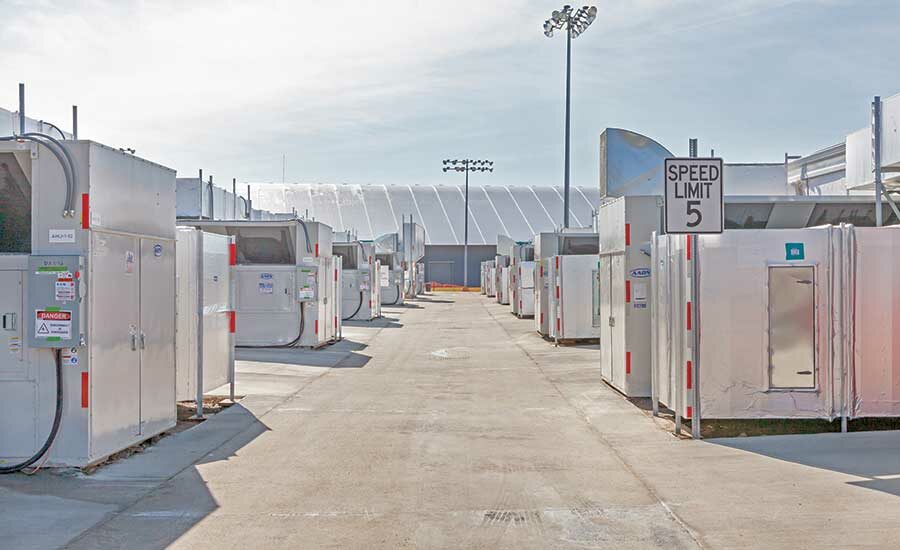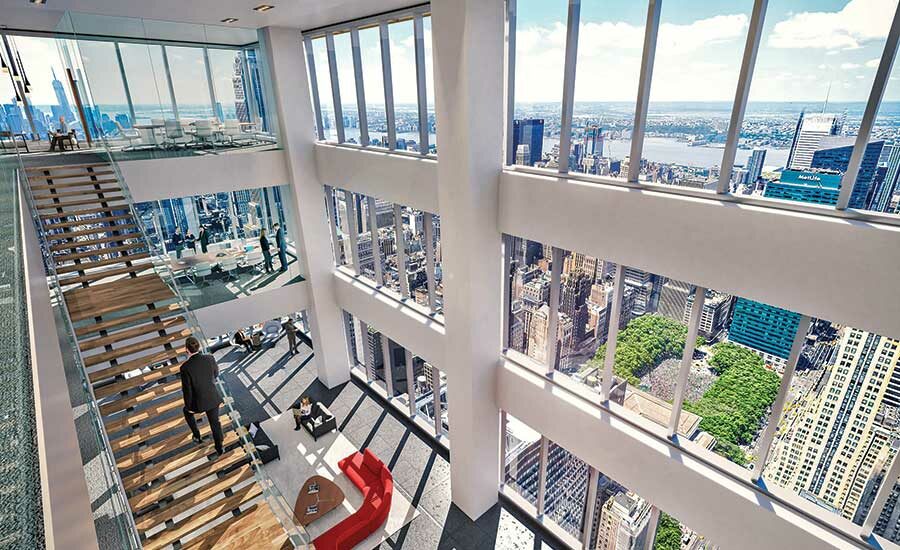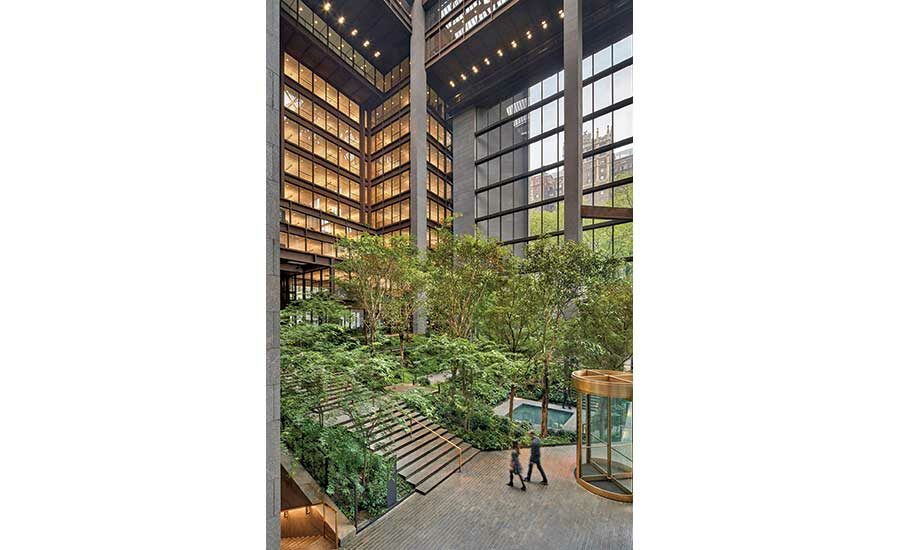Jaros, Baum & Bolles has spent 105 years as a leading mechanical, electrical and plumbing design firm adapting to ever-changing dynamics in the New York City regional market and beyond. But its next generation of business will feature much more of that.
The JB&B team over the past decade has expanded from its core as a project-focused MEP consultant based in Manhattan to embrace a far more substantial advisory role, one that adapts to client needs with innovative solutions. The three managing partners who now lead the firm—Scott Frank, Walter Mehl Jr. and Mark Torre—see two main arenas where its expertise will be in greatest demand: sustainable design and technology innovation. “Sometimes we don’t get to write the script of who we want to be,” Mehl says. “If for the first 100 years we were primarily an MEP design firm, in the second hundred years we’re going to be more of a services firm, offering a whole host of other services that round out what our clients need.”
With its focus on clients’ future design requirements for everything from green buildings to COVID-19 pandemic-spurred office space hygiene—and its role in major projects, including The Shed, ENR New York’s Project of the Year last year—JB&B was selected as the magazine’s Design Firm of the Year for 2020.
Sustainable design has been a main focus, with clients asking JB&B to be their go-to partner for solutions, Mehl says. New York City property owners must build strategies that move toward a municipal 2050 target of reducing carbon emissions by 80%.
JB&B has stepped up, says Frank, who has been board chair of the Urban Green Council since 2017. The firm guides clients to optimize design, construction and operations features for greater energy efficiency and carbon reduction on new projects and also to calculate the value of retrofits on existing structures while understanding complex climate impact regulations, he says.
“[Sustainability] is an area we’ve had a lot of focus on and a lot of presence in,” Frank says. “And we anticipate it will become a very big part of our practice.”
JB&B also has cultivated a culture of technology innovation—adopting pioneering tools as well as developing advanced systems and smart building components, Torre says. It is using that prowess to help clients determine their own technology needs, he says. “We see our clients’ future need for more technology services” such as cybersupport and digital infrastructure, he notes.
JB&B’s focus is where it should be, says Jay Simson, president and CEO of the American Council of Engineering Cos. of New York, because engineers have to be “at the top of their game” around technology and sustainability initiatives.
“You constantly need to be educating yourself, staying on the leading edge, or someone else will step in,” he says.
Independent Leadership
JB&B’s pivot to broader client challenges builds on a history of innovating on high-profile projects, Frank says, such as being the first MEP firm to design a sprinkler system for a high-rise building—a feat achieved at the Sears Tower in Chicago, the world’s tallest tower when it opened in 1973. The firm also designed the first high-speed elevators in the original World Trade Center in New York City several years earlier.
“In our DNA, there is an innate interest in solving new problems,” Frank says. Another pillar of JB&B’s culture is that many professionals have spent their entire careers there, he says. And today’s managing partners view themselves as stewards of the company, leading it to the next generation, Torre adds.
But the firm’s ability to chart a course into new areas is primarily the result of two other attributes—its independence and collaborative ethos.
“We’re autonomous, we’re not part of a multinational corporation,” Frank says. “We take the long-term view.”
The firm’s 19 partners are able to react nimbly to client needs, stemming from a deliberate shift seven years ago, Torre says. “We went from command and control to a more distributed leadership model,” he says. “Everybody has latitude [grounded in] our core values.”
“Distributed” also can describe JB&B’s project breadth—its $70.5 million in 2019 revenue spreads across sectors, with commercial as the largest at $20.2 million. It also has a significant presence in health care, multi-unit residential, government, retail, nonprofit and research facilities. Notable projects include Memorial Sloan Kettering’s David H. Koch Center for Cancer Care, a 23-story high-tech facility that opened last year, and the 1.7-million-sq-ft One Vanderbilt mixed-use tower nearing completion in midtown Manhattan, which has extensive sustainable design features.
“The JB&B team developed a sensible and economical state-of-the art MEP design for [One Vanderbilt], with added sustainability features that have contributed to the building’s LEED Platinum and WELL certifications,” says Edward Piccinich, chief operating officer of its developer SL Green. “This innovation is evident throughout the design—from secondary backup systems like our cogeneration plant, condenser, hot water and electrical systems to our rainwater collection system.”
Industry leadership is another key trait, with JB&B staff serving on many industry organizations. Mehl is on the board of the ACE Mentor Program of Greater NYC; Mitchel Simpler, a partner and managing partner emeritus, is this year’s national ACEC chair; and Anthony Montalto, an associate partner, is on the board of Habitat for Humanity’s New York City chapter.
Invested in Innovation
JB&B’s tilt toward embracing new solutions is evident in its efforts to develop, invest in and adopt new technologies.
A prime example is the firm’s work on solutions to “end the thermostat wars” in open-plan office designs —an initiative that Gabriel Peschiera, JB&B director of smart buildings, described last fall at the Council on Tall Buildings and Urban Habitat’s 10th World Congress in Chicago. His presentation outlined a “personal thermal preference” system to address a top office complaint—that spaces are too hot or too cold—by allowing occupants as close as 5 ft apart to set their own air conditions via a web browser while still meeting aesthetic, cost and energy use criteria.
JB&B is moving ahead as an active stakeholder in manufacturing personal air delivery products in that vein, Frank says.
JB&B also is a key partner in THRUX, an MEP “design environment” startup launched last year by two of the firm’s former engineers, Michael Taglione and Haley Neiman. The software platform allows users to quickly calculate the cost and implications of changes in a project’s design to compare different options; automate manual tasks; and streamline spreadsheet, drafting and drawing tools that engineers use. JB&B has not only invested in Thrux but also is using the system for electrical and some mechanical processes, with plans to expand it across the firm, Torre says.
“It eliminates calculation errors, increases efficiency and is much faster,” he notes. “And if you do something that is not per code or does not meet the design criteria for the project, it will flag it.”
It’s also a way to anticipate the future, Frank says. “Some people joke that we’re designing our own obsolescence,” he says. “We like to be out in front.”
JB&B also was an early user of virtual reality software in BIM planning, tapping into the Immersify platform developed by LERA Consulting Structural Engineers. “LERA has partnered with JB&B on numerous new and renovated health care and cogeneration projects, where they are consistently looking at how to leverage reliable advanced technology for their clients’ benefit,” says Doug González, associate partner at LERA.
New Services Drive Growth
The willingness to meet client needs has pulled JB&B toward growth opportunities and its building teams to deliver new services. It’s a strategy that industry leaders pursue, ACEC’s Simson says.
“One of the key elements is working with your clients as a trusted adviser to be a resource beyond engineering,” he says. “JB&B has been a leading firm that has taken chances to be a bit more creative.”
The firm has built skills around what the market needs, Mehl says. “Part of it is the client saying, ‘Could you help me move in this direction?’” he says.
That has led JB&B to build out specialties in information technology, cybersecurity, audio-visual, smart building and other consulting areas, Mehl says. It also has developed capabilities on its core MEP teams to support construction partners, manufacturers or consultants as needed, he says. “We can be more amorphous and flexible,” he adds.
Those cumulative efforts have fueled JB&B’s growth from 200 staff members early last decade to 300 now. “Some of that talent is born within our teams, and some of it is going out to the industry to bring in the right people,” Mehl says.
Coronavirus Response
JB&B’s versatility served it well as the COVID-19 pandemic hit the region in March, not only shifting smoothly to work from home, but also joining other industry firms to design temporary field hospitals, including 1,028 beds at Stony Brook University, 1,024 at SUNY Old Westbury and 200 at Van Cortland Park in the Bronx.
But the shutdown has directly impacted the firm’s work. JB&B has several projects that stopped construction and are only starting to come back, with their future uncertain for now, Torre says.
Project designs are also undergoing swift changes, Mehl says. “Designs that were very mature are now rethinking how [to] include some of these … new measures,” he says.
Designs still in development may get even more sweeping reboots that anticipate the future workplace, Frank says. “One project for [a large client] in early stages already is looking at a dramatic pivot in design direction,” he says.
JB&B is also fielding requests from clients about how to recover from the coronavirus pandemic shutdown’s economic shock and the real estate implications of social distancing and enhanced hygiene. Torre and a colleague are on an ad-hoc industry committee hashing through the new reality, he says.
“We have a group of engineers and architects … meeting to discuss how we’re going to get people back to work safely,” Torre says. “There are a lot of questions in real estate that need to be answered.”
Engineering firms such as JB&B will make outsized contributions to future standards, says Carlo Scissura, president and CEO of the New York Building Congress. “They will play a critical role as we look at working differently,” he says. “Now, it’s not just climate change but also designing for how we work and move around.”
But much like Superstorm Sandy in 2012, when JB&B helped restore power to buildings and rebuild infrastructure, the firm will be ready for the coming wave, Frank says. “We have clients in crisis, asking what needs to be done to reoccupy their spaces,” he says. “It will be a very active process in the coming weeks.”






Post a comment to this article
Report Abusive Comment